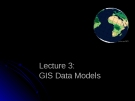Lecture 3: Lecture 3: GIS Data Models GIS Data Models
To introduce various GIS data models AIM:AIM: To introduce various GIS data models
After this lecture you should be able to: After this lecture you should be able to:
Describe the primary Vector data models Describe the primary Vector data models used in GIS and give examples used in GIS and give examples Describe raster data models and give Describe raster data models and give examples examples Describe TIN data models Describe TIN data models Explain “topology” Explain “topology” Describe the main file formats used in GIS Describe the main file formats used in GIS
Graphic Features Graphic Features
Objects which are shown on a map are Objects which are shown on a map are called graphic features or features. called graphic features or features. These features may be natural or man These features may be natural or man made objects. made objects.
Digital representation of physical or man made Digital representation of physical or man made elements: elements:
Vectors Vectors Points or Nodes Points or Nodes Lines or Arcs Lines or Arcs Polygons Polygons Raster Cells or Pixels Raster Cells or Pixels Images Images Digital Orthophotography Digital Orthophotography
Graphic Features Graphic Features
Images Images Vector Vector Raster (GRID) Raster (GRID) Attributes Attributes TIN ( Triangulated Irregular Network)) TIN (Triangulated Irregular Network Annotation Annotation
© Paul Bolstad, GIS Fundamentals
Geographic Data Types Geographic Data Types
© Paul Bolstad, GIS Fundamentals
Geographic Data Types Geographic Data Types
• RASTER
• VECTOR
• Real World
Source: Defense Mapping School National Imagery and Mapping Agency
DIGITAL SPATIAL DATA DIGITAL SPATIAL DATA
Electronic Maps in Raster and Electronic Maps in Raster and Vector Formats Vector Formats
Raster Data Sources Raster Data Sources
Air Photos
Satellite Imagery
Scanned Maps
A scanned photograph that
has been mathematically rectified to eliminate the
effects of displacement so
that its view always appears as though it is perpendicular
to the ground.
Digital Orthophotograph Digital Orthophotograph
Image Copyright 1993 Nassau County, NY
Scanned Scanned Document Document
Raster Maps (images) Raster Maps (images)
A set of colored pixels A set of colored pixels representing chart representing chart information as a picture on information as a picture on computer screen computer screen
Simply an array of pixels Simply an array of pixels arranged in rows and arranged in rows and columns columns
Pixels are color coded, but Pixels are color coded, but do not represent features do not represent features explicitly explicitly
Rasters can have value Rasters can have value attached attached
Source: Defense Mapping School National Imagery and Mapping Agency
The Appeal of Raster The Appeal of Raster
Looks like a paper map Looks like a paper map
Cheap and easy to produce (scan Cheap and easy to produce (scan existing paper chart) existing paper chart)
Runs easily on PC Runs easily on PC
World-wide availability w/updates World-wide availability w/updates available available
Problems: Problems:
Datum may or may not be WGS84 Datum may or may not be WGS84 Does not allow automated grounding Does not allow automated grounding avoidance or any other computer- avoidance or any other computer- aided analysis aided analysis Storage not as efficient Storage not as efficient
Source: Defense Mapping School National Imagery and Mapping Agency
An intelligent form of digital An intelligent form of digital geographic data where real world geographic data where real world objects are represented by points, objects are represented by points, lines and polygons. An objects lines and polygons. An objects representation is described by representation is described by attributes and coordinates. attributes and coordinates.
Examples include: Examples include: Digitized Maps Digitized Maps GIS Data GIS Data
Source: Defense Mapping School National Imagery and Mapping Agency
Vector Data Vector Data
In addition to
Linking Attributes and Linking Attributes and Graphics Graphics
eography, In addition to GGeography, GIS is also about GIS is also about IInformation. A GIS marries nformation. A GIS marries the capabilities of computer the capabilities of computer mapping with database mapping with database management systems. So, management systems. So, a geospatial analyst can a geospatial analyst can “click” on a geographic “click” on a geographic feature and find out feature and find out information about it. Or, information about it. Or, they can query the database they can query the database to find out information about to find out information about all the geographic objects all the geographic objects that meet a specific criteria. that meet a specific criteria. Information about a Information about a geographic object is called geographic object is called attribute.. an an attribute
Linking Attributes with Graphics Linking Attributes with Graphics
In this example, the In this example, the user has issued a user has issued a query to select all query to select all the properties the properties whose classification whose classification is single family is single family residential (210), residential (210), and colored the and colored the selection red. selection red.
•
•
1
•
5
Vector Data is Layered Vector Data is Layered
Features: Line Points:
2 • • 4
•Lake • Lake
•
Connected Detached
•
•
7
6
Area Text
• •
Spatial Data Analysis
30ł 30’ N 040ł 40’ E
30ł 30’ N 040ł 50’ E
Geographic data are separated into themes, tiled for speed of access and placed on CD-ROM Network Analysis
Source: Defense Mapping School National Imagery and Mapping Agency
Source: Defense Mapping School National Imagery and Mapping Agency
Paradigm Shift Paradigm Shift May look “different” from a May look “different” from a paper map (software- paper map (software- dependent) dependent) Underlying database allows Underlying database allows queries and layer selection queries and layer selection Zooming reveals detail Zooming reveals detail Complex, expensive, and Complex, expensive, and time-consuming to produce time-consuming to produce
Raster and Vector Data Models Raster and Vector Data Models
Real World
600
Trees
500
1 2 3 4 5 6 7 8 9 10 G G G
B B
400
Trees
Y-AXIS
G G
300
B B G G B B
BK
House
B
200
River
100
G G
200
500
100
300
600
B B B B
1 2 3 4 5 6 7 8 9 10
Raster Representation
400 X-AXIS Vector Representation
Source: Defense Mapping School National Imagery and Mapping Agency
A GIS in which graphic data is stored in the A GIS in which graphic data is stored in the form of discrete points, lines, or polygons. form of discrete points, lines, or polygons.
Vector GIS Vector GIS
© Paul Bolstad, GIS Fundamentals
There is a relationship between vector data types. There is a relationship between vector data types. Each data type is often dependent upon one Each data type is often dependent upon one another. When representing geographic data in another. When representing geographic data in vector format, data is typically stored as: vector format, data is typically stored as:
Points
Point
Lines
Line
Polygon
Structure of Vector Data Structure of Vector Data
Points: points are zero dimensional objects, and : points are zero dimensional objects, and represent geographic features such as wells, represent geographic features such as wells, sample locations, or trees. sample locations, or trees. Lines: lines represent one dimensional objects, or : lines represent one dimensional objects, or linear features, such as road and stream linear features, such as road and stream centerlines. Lines are made up of a series of centerlines. Lines are made up of a series of interconnected points. A line typically starts and interconnected points. A line typically starts and , and the node, and the end with a special point called a node end with a special point called a points that make up the rest of a line are called points that make up the rest of a line are called vertices. . vertices Polygons/Area Polygons/Area: polygons represent two : polygons represent two dimensional objects such as the boundaries of a dimensional objects such as the boundaries of a field, or property, or the outline of a building or lake. field, or property, or the outline of a building or lake. Polygons are made up of a series of connected Polygons are made up of a series of connected lines where the starting point of a polygon is the lines where the starting point of a polygon is the same as the ending point. same as the ending point.
Points are zero dimensional objects
which have locations and attribute information but are too small to be
represented as areas.
Points Points
Soil Samples Soil Samples TypeType PHPH Contaminants Contaminants Utility Poles Utility Poles Owner Owner Height Height Attachments Attachments
Spill Locations Spill Locations Accident Number Accident Number Type of Spill Type of Spill Extent Extent Parcel Centroids Parcel Centroids Section/Block/Lot No. Section/Block/Lot No. Address Address Owner Owner Assessment Data Assessment Data
Points Points
Light Poles Light Poles
Parcel Centroids Parcel Centroids
Lines are one dimensional objects Lines are one dimensional objects which have length but no area. which have length but no area. Each line must begin and end at a Each line must begin and end at a node. node.
Lines or Arcs Lines or Arcs
Stream Stream DepthDepth Quality Quality Flow Rate Flow Rate
Street Centerline Street Centerline Street Name Street Name Address Ranges Address Ranges Water Main Water Main Pipe size Pipe size Pipe Material Pipe Material Date Installed Date Installed
Lines or Arcs Lines or Arcs
Street Centerlines Street Centerlines
Polygons are closed mathematical Polygons are closed mathematical figures of any shape or size. They are figures of any shape or size. They are formed by a series of connected lines. formed by a series of connected lines.
Polygons Polygons
Parcel Parcel Parcel ID Number Parcel ID Number Dimensions and Area Dimensions and Area Soil Boundaries Soil Boundaries TypeType Permeability Permeability Flood Zones Flood Zones
Polygons Polygons
Polygons Polygons
Polygons Polygons
Linked” Attribute Data ““Linked” Attribute Data
Tabular Data Tabular Data (Attributes) (Attributes)
© ESRI
Information which describes an entity Information which describes an entity represented by a graphic feature. represented by a graphic feature.
Attribute Data Attribute Data
Information about a graphic feature Each piece of attribute information is related Each piece of attribute information is related to a specific graphic element to a specific graphic element Traditional database type fields Traditional database type fields Images Images Photos Photos Video Video
Attribute Data Attribute Data
Linked” Attributes ““Linked” Attributes
Courtesy Village of Garden City
A GIS in which graphic data is stored in A GIS in which graphic data is stored in the form of grid cells or pixels. the form of grid cells or pixels.
Part 3: Raster GIS Part 3: Raster GIS
Geographic Data Sets Geographic Data Sets Land Use/Land Cover Land Use/Land Cover Vegetation Index Vegetation Index Soil Stability Soil Stability Digital Photography Digital Photography Building Photos Building Photos Accident Scenes Accident Scenes Crop Damage Crop Damage Full Motion Video Full Motion Video Digital Orthophotography Digital Orthophotography Rectified Aerial Photos Rectified Aerial Photos
Raster Data Raster Data
© ESRI, Modeling Our World
Abbreviation for PICTURE ELEMENT Abbreviation for
, which is the PICTURE ELEMENT, which is the
smallest unit in an image. In raster based GIS smallest unit in an image. In raster based GIS systems, attribute information can be assigned to systems, attribute information can be assigned to each pixel. each pixel.
PIXEL PIXEL
© ESRI, Modeling Our World
© ESRI, Modeling Our World
Matrix of Equal-Area Cells Matrix of Equal-Area Cells
Raster Data Structure Raster Data Structure
WHEAT
APPLES
WHEAT
APPLES
HAY
HAY
Issue of Resolution Issue of Resolution
Must Consider Must Consider Discreteness of the entity being depicted Discreteness of the entity being depicted Intended application (efficiencies) Intended application (efficiencies) Source data Source data Storage considerations Storage considerations Resolution Resolution ColorColor
Raster Vs. Vector Raster Vs. Vector
People often ask: “what is the best format to represent geographic objects in a GIS, raster of vector?” The answer is actually neither and both! That is, neither data model is better in every circumstance, and both data models fulfill very specific roles in GIS.
Shoreline Shoreline
Water Water
Land Land
In this example, the vector data source representing the shoreline appears to have greater detail, and possibly greater accuracy. Vector data can often store the information in a more compact format than raster data, and also work well with linear objects such as stream networks.
Vector Shoreline Vector Shoreline
However, raster data models are much better at representing information that is continuous in nature, such as temperature where the value of temperature may be different between neighbors.
Source: Defense Mapping School National Imagery and Mapping Agency
Raster vs. Raster vs. Vector Model Vector Model
Advantages Advantages Good representation of reality Good representation of reality Compact data structure Compact data structure Topology can be described in a network Topology can be described in a network Accurate graphics Accurate graphics Disadvantages Disadvantages Complex data structures Complex data structures Simulation may be difficult Simulation may be difficult Some spatial analysis is difficult or impossible to Some spatial analysis is difficult or impossible to perform perform
Vector – Advantages and Vector – Advantages and Disadvantages Disadvantages
Advantages Advantages Simple data structure Simple data structure Easy overlay Easy overlay Various kinds of spatial analysis Various kinds of spatial analysis Uniform size and shape Uniform size and shape Cheaper technology Cheaper technology Disadvantages Disadvantages Large amount of data Large amount of data Less “pretty” Less “pretty” Projection transformation is difficult Projection transformation is difficult Different scales between layers can be a nightmare Different scales between layers can be a nightmare May lose information due to generalization May lose information due to generalization
Raster – Advantages and Raster – Advantages and Disadvantages Disadvantages
Raster Functions
© Paul Bolstad, GIS Fundamentals
Triangulated Irregular Network Triangulated Irregular Network
A triangulated irregular network
(TIN) is a data model that is used to represent three dimensional objects. In this case, x,y, and z values represent points. Using methods of computational geometry, the points are connected into what is called a triangulation, forming a network of triangles. The lines of the triangles are called edges, and the interior area is called a face, or facet. While the TIN model is somewhat
more complex than the simple point, line, and polygon vector model, or the raster model, it is actually quite useful for representing elevations. For example a raster grid would require grid cells to cover the entire surface of a geographic area. Also, if we wanted to show great detail we would have to have small grid cells. Now, if the land area is relatively flat, we would still need the small grid cells. However, with a TIN we would not have to include so many points on the flat areas, but could add more points on the steep areas where we want to show greater detail.
The illustration shows how we can create a TIN of the terrain around Ithaca, NY.
The tin data structure is The tin data structure is based on two basic elements: based on two basic elements:
points with x,y,z values, and a points with x,y,z values, and a series of edges joining these points series of edges joining these points to form triangles. to form triangles. This triangular mosaic forms a This triangular mosaic forms a continuous faceted surface, much continuous faceted surface, much like a jewel. like a jewel. TIN’s triangulation method satisfies TIN’s triangulation method satisfies the Delaunay criterion the Delaunay criterion
TIN Data Structures TIN Data Structures
Delaunay Criterion The triangulation algorithm ensures that the Delauney criterion is satisfied. The Delauney criterion is such that the circumcircle of a triangle does not enclose a node on any other element. The circumcircle of a triangle is the circle that passes through its vertices.
Components of a TIN Components of a TIN
TIN is a set of adjacent, non-overlapping triangles computed from irregularly spaced points with x, y coordinates and z values.
ArcGIS supports two data models of elevation: TIN
and lattice.
Nodes Nodes Edges Edges Triangles Triangles HullHull Topology Topology
Nodes:
Edges:
Triangles:
Nodes: nodes are the fundamental building blocks of the tin. The nodes nodes are the fundamental building blocks of the tin. The nodes originate from the points and arc vertices contained in the input data originate from the points and arc vertices contained in the input data sources. sources. every node is joined with its nearest neighbors by edges to form Edges: every node is joined with its nearest neighbors by edges to form triangles which satisfy the Delaunay criterion. Each edge has two nodes, triangles which satisfy the Delaunay criterion. Each edge has two nodes, but a node may have two or more edges. but a node may have two or more edges. Triangles: Each triangular facet describes the behavior of a portion of the Each triangular facet describes the behavior of a portion of the tin’s surface. tin’s surface.
Topology:
Hull:Hull: The hull of tin is formed by one or more polygons containing the entire The hull of tin is formed by one or more polygons containing the entire set of data points used to construct the tin. The hull polygons define the set of data points used to construct the tin. The hull polygons define the zone of interpolation of the tin. zone of interpolation of the tin. Topology: The topological structure of a tin is defined by the relationship The topological structure of a tin is defined by the relationship between nodes, edges (number and type), and by the relationship between nodes, edges (number and type), and by the relationship between adjacent triangles. between adjacent triangles.
Like an ARC/INFO coverage, a tin is stored as a directory of Like an ARC/INFO coverage, a tin is stored as a directory of files. However, a tin is not a coverage and has no associated files. However, a tin is not a coverage and has no associated INFO files. A tin directory contains seven files containing INFO files. A tin directory contains seven files containing information about the tin surface. These files are encoded in information about the tin surface. These files are encoded in binary format and are not readable by standard text display. . binary format and are not readable by standard text display
Components of TIN (in detail) Components of TIN (in detail)
© ESRI, Modeling Our World
© ESRI, Modeling Our World
Text or labels plotted on a map which describe or identify a feature or add other information to the map.
Annotation Annotation
TextText
Information placed on a map to provide Information placed on a map to provide additional information about a graphic feature. additional information about a graphic feature.
Symbols Symbols The means by which graphic features are The means by which graphic features are displayed in a GIS. displayed in a GIS.
Annotation Annotation
Symbols help identify features and Symbols help identify features and provide information about them. provide information about them. q c , P X q c , P X
Symbols Symbols
Annotation, Symbology, and Text Annotation, Symbology, and Text
Courtesy Village of Garden City
Engineering drawing – building outline Engineering drawing – building outline USGS Quad Sheet – point location USGS Quad Sheet – point location
CityCity
USGS Quad Sheet – Polygon of city boundary USGS Quad Sheet – Polygon of city boundary Rand McNally Map – Point representing city location Rand McNally Map – Point representing city location
Issues of Scale in Feature Issues of Scale in Feature Representation Representation Depending upon the presentation scale, a feature Depending upon the presentation scale, a feature may take on different forms may take on different forms Buildings Buildings
Topology Topology
A collection of numeric data which clearly A collection of numeric data which clearly , and containment, and describes adjacency describes
adjacency, , containment
between map features connectivity between map features connectivity and and which can be stored and manipulated by a which can be stored and manipulated by a computer. computer.
© Paul Bolstad, GIS Fundamentals
Topology Topology
ArcView is a file based, non topological, ArcView is a file based, non topological, pseudo object-oriented graphic data pseudo object-oriented graphic data structure structure
ARC/INFO vs. ArcView ARC/INFO vs. ArcView ARC/INFO is a topologically based hybrid ARC/INFO is a topologically based hybrid system system
ARC/INFO Coverage ARC/INFO Coverage ArcView Shape ArcView Shape Geodatabase Layer Geodatabase Layer AutoCAD DWG/DXF AutoCAD DWG/DXF MapINFO MapINFO OtherOther
File Formats File Formats
The shapefile format defines the geometry and The shapefile format defines the geometry and attributes of geographically-referenced features attributes of geographically-referenced features in as many with specific file extensions that in as many with specific file extensions that must be stored in the same project workspace. must be stored in the same project workspace. They are: They are: .shp - the file that stores the feature geometry. .shp - the file that stores the feature geometry. Required. Required. .shx - the file that stores the index of the feature .shx - the file that stores the index of the feature geometry. Required. geometry. Required. .dbf - the dBASE file that stores the attribute .dbf - the dBASE file that stores the attribute information of features. Required. information of features. Required. .sbn and .sbx - the files that store the spatial index of .sbn and .sbx - the files that store the spatial index of the features. Optional. the features. Optional.
The Shape File The Shape File
© ESRI, Modeling Our World
© ESRI, Modeling Our World
Homework Homework

















